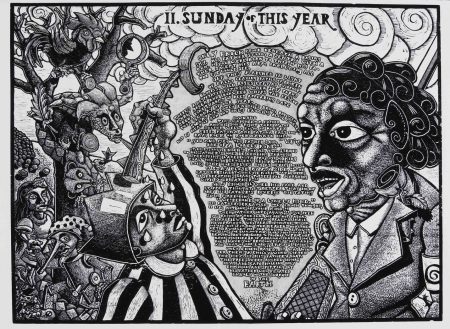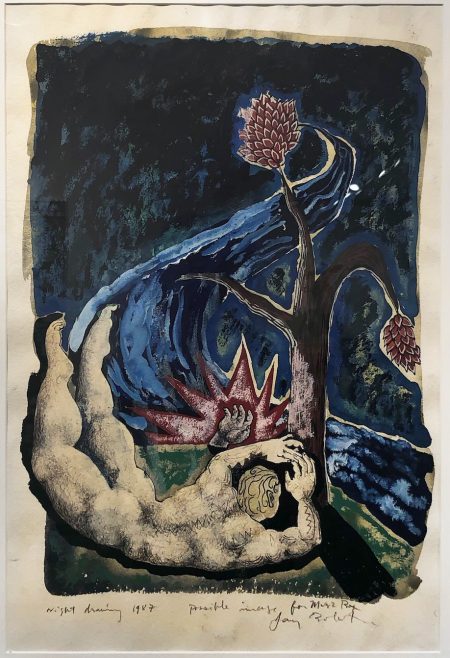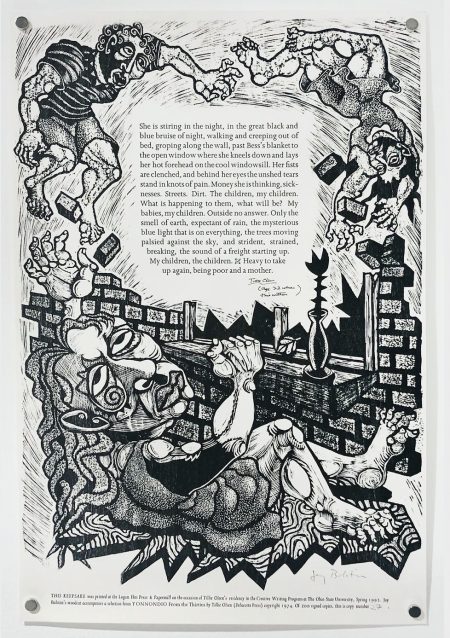Jay Bolotin began exhibiting works of art at the Carl Solway Gallery in the 1970s. Nearly fifty years later, he maintains his relationship with the venue, which has staged a retrospective surveying his catalog of drawings, writings, sculpture, theatre, music, and film. That catalog pays homage to a variety of predecessors, demonstrating his deep feeling for the work of William Blake and Thomas Hart Benton as well as his personal connections to Tillie Olsen, Isabella Gardner, and Allen Ginsburg. Bolotin ranges freely between diverse modes and media, showing startling facility with each one and an even more remarkable ability to merge them. His genre-defying composites fuse prose poems and surreal libretti with woodcuts, etchings, mechanical figures, and animated cinema. His concerns run toward the spiritual and the otherworldly even as his pieces remain grounded in the material history of working-class Jewish life in the U.S.
This combination of the fanciful and the concrete best expresses itself in The Book of Only Enoch, a work of twenty large-format panels that encircle one spacious room in the gallery. Bolotin designed those panels from 2011 to 2014, producing an illuminated manuscript that reflects his Kentucky roots and his penchant for epic storytelling. The book treats coal country as the setting for a dark fairy tale, incorporating visual details akin to those of Renaissance woodcuts as well as comics and graphic novels. The central character derives in part from a lost book of the Hebrew testament, where Enoch was the rare human permitted to observe the angels and live to report his experience. In Bolotin’s version, the lonely, misunderstood “Only Enoch” has fantasies of flight but remains largely landlocked in a world of itinerant labor, cruel bosses, asylums, homelessness, and hunger. But he also meets compassionate fellow travelers on his journey, finding love and creative satisfactions along the way.
The plate called Sunday of This Year finds Only Enoch wrestling with his father Daniel’s expectations in the days before the journey begins. As man and boy move through the hills together, Daniel depicts their bond as one of life-long isolation: “You and me…We’re one of a lonely kind.” Counseling Enoch to stay close, he proudly announces that “the necks of generations crane to see you marching with your father.” But while Enoch has the trademark knobbiness of a puppet, he refuses to bend to the dictates of others, whether parents or ancestors. “I’m not one of your kind,” he thinks, defying the logic that would plot his footsteps in advance. The alternative to such plotting, however, remains unclear to young Enoch, who has not yet summoned the courage to leave home.
As the protagonist distances himself from Daniel’s influence, the panel visualizes the characters and dangers that await him, some of them imagined and some seeming to beckon from the future. A rooster looks on, signaling the morning of Enoch’s long day, the beginning of his maturation. A snake-like figure tempts him with knowledge, holding up a glass that magnifies a cloudburst of text at the core of the page. That text rises into the heavens like Enoch’s namesake, promising a look at the divine. He surveys his future with a certain eagerness, but only while wearing an armband that ties him to deeper, more sinister histories than those Daniel mentions. In place of a star, however, we find on that armband a spiral, which quietly repeats itself in his lapel, his hair, and the shape of the clouds. That spiral suggests the presence of centrifugal and centripetal forces—the expansive motion that takes in ever greater layers of experience, and the inward pull that tethers him to rural Kentucky.

Sunday of this Year from The Book of Only Enoch, 2011-2014
The tensions between rootedness and the explorer’s desire, between the gravity of heritage and the urge toward innovation, play out in Bolotin’s music as well as his visual expression. The song “A Father and His Son” reprises Only Enoch’s psychological drama, contrasting the insistence that “We’re one of a lonely kind” with “Daddy, this is not for me.” Like Bolotin’s room-sized book, his songs deliver the larger-than-life characters of nineteenth-century fiction, figures at once mythic and highly specific. The artist pays loving attention to misfits, people too sensitive or strange for the workaday world, as they encounter unsavory and even predatory characters along the road. As such meetings unfold, the musical style mixes the zany and the macabre, combining orchestral music with ancient chant, folk, and New Orleans big band, all while calling to mind the playfully grim scores of Danny Elfman. Bolotin delivers the lyrics more as operatic recitative than popular song, though there are moments of soaring melody that create an anthem-like effect. The vocals suggest an odd blend of Bob Dylan, Elvis Costello, and Tom Waits, ranging between the mellow and the monstrous depending on character and situation.

Night Drawing, 1987
Many of those characters and situations have been in development since Bolotin’s 1970s exhibitions, showing up in sculptures and live performances as well as music and drawings. Like Only Enoch, his protagonists often experience contrary pulls toward celestial knowledge and communion with the earth. We encounter this opposition in the 1987 Night Drawing, where a naked figure peers into the base of a tree beside a rushing stream. The man’s musculature recalls the plates of Blake, as does his organic relation to the natural environment. He flows like the river and clings to the ground but also has a cloud-like consistency; he is both animal and angel. His examination of the tree, with its boughs of otherworldly fruit, conveys Bolotin’s career-long fascination with Judeo-Christian creation stories. Calamity unfolds at the water’s edge, awaiting those who pursue forbidden knowledge. Yet the artist’s body of work consistently affirms the urge to venture out and investigate, to subvert artistic conventions and predetermined sociopolitical frameworks. A related plate in an adjacent room of the gallery attributes similar tendencies to Blake, who emphasized the critical, disruptive character of imagination, which for him was “not a state” but “the human existence itself,” not a restricted, temporary phenomenon but an ontological condition.

Keepsake honoring Tillie Olsen’s Yonnodio: From the Thirties,
created for her residency at The Ohio State University in 1992
Only Enoch’s spiraling endeavor, his reaching toward the ethereal and bringing news back to earth, embodies the Blakean view of imagination as a form of life. Enoch strives toward spiritual vision but with the specific aim of sharing it with his worldly counterparts, and better still, enriching the lives of the poor and neglected. Bolotin’s identification with the downtrodden expresses itself in his admiration for Tillie Olsen, whose Great Depression-era classic Yonnondio, From the Thirties influences the prose of The Book of Only Enoch as well as Bolotin’s songs. When Olsen undertook an artistic residency at The Ohio State University in 1992, Bolotin crafted a keepsake drawing to honor a passage from the novel. In that passage, a mother longs for children who, following their own imaginative paths, have left home in the middle of economic catastrophe. She looks for comfort in her natural surroundings but finds little—“only the smell of earth, expectant of rain, the mysterious blue light that is on everything, the trees moving palsied against the sky, and strident, strained, breaking, the sound of a freight starting up … Heavy to take up again, being poor and a mother.” As the heaviness weighs on her, the bricks dislodge from her house and rise with the children into a swirling storm. Everything becomes unmoored as the bereft Madonna looks on, fist clenched, tears flowing in the characteristic spiral shape. She knows that the children’s journeys, like those of Enoch, will as likely bring ruin as wisdom. It is the uncertainty of the outcome that awakens her to the “the great black and blue bruise of night,” a foreboding that cannot be distinguished from the atmosphere.
Bolotin shares Olsen’s gift for characterization and her ability to render affective intensities through visual poetry. Both artists filter bleak living and working conditions through lyrical flights of imagination, which again constitute a way of being rather than singular acts. The ontological character of the imagination becomes especially clear at Bolotin’s retrospective, as he develops what we might call mystic materialism across five decades. His art spirals outward toward wild fantasy while circling back incessantly to the social and the real, if not exactly to social realism. That process brings illuminated manuscript into dialogue with folk art, sacred icons into relation with the vagabonds of pulp fiction. The resulting plates demand slow investigation, spilling over with pictorial and alphabetic detail that can take hours if not days to assimilate. A career’s worth of such pieces feels overwhelming, even as the Solway manages to get it into two rooms. Absorbing the full effect may require multiple visits to the gallery. But those visits will be well worthwhile, as Bolotin’s mystic materialism provides an entry point into some of the richer discourses in twentieth-century art and literature, and a glimpse of the hybrid genres taking shape in the twenty-first.
–Christopher Carter



